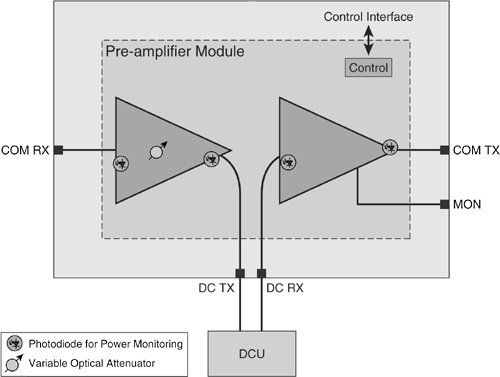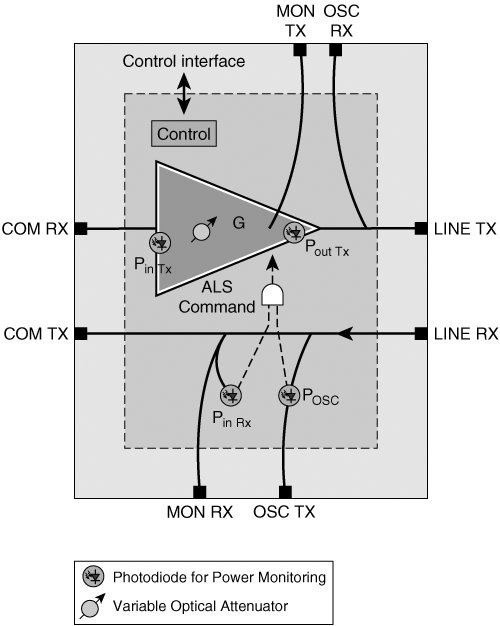ONS 15454 MSTP Optical Amplifiers
| Optical amplifiers are used in the ONS 15454 MSTP system for two primary purposes:
Each function demands specific characteristics from the amplifier. Typically, a preamplifier is optimized for low power and low noise. Conversely, a booster amplifier is usually characterized by a high-output, high-noise gain profile. Additionally, for high bit-rate optical signals (for example, OC-192 and above), chromatic dispersion compensation is typically needed to recover severely impaired optical pulses because of fiber nonlinear effects. Although dispersion compensation can be accomplished anywhere within the DWDM network, it is typically done at amplifier sites to mitigate the optical attenuation loss associated with dispersion compensation fiber. The OPT-PRE amplifier is designed to allow for dispersion compensation insertion between amplifier gain stages. Finally, amplifiers must be capable of dynamically adjusting to the addition and insertion of DWDM wavelength channels so that amplifier power gain is always uniformly distributed among the ITU-T channels. This section examines the pre/booster amplifier cards for the ONS 15454 MSTP system as they relate to these functional characteristcs. OPT-PREThe OPT-PRE is an EDFA operating in the ITU-T DWDM C-band at 50 GHz stability. The ONS 15454 currently operates at only the 32-channel 100 GHz ITU-T grid; however, the amplifiers used in the system are scalable to accommodate an upgrade to 64 channels. The OPT-PRE employs a two-stage gain operation that allows for mid-stage access for dispersion compensation insertion. Because the DWDM wavelength channels within the composite optical signal might have uneven power levels, the OPT-PRE employs an automatic VOA on the incoming signal to ensure even amplified optical gain among each wavelength channel, to control gain tilt. The amplifier also employs fast transient suppression to adjust for DWDM channel count changes and power fluctuations because of network disruptions. The OPT-PRE can operate in two user-provisionable modes:
Table 9-8 details the optical characteristics of the OPT-PRE. Figure 9-20 illustrates a block diagram of preamplifier operation in the ONS 15454 MSTP system.
Figure 9-20. OPT-PRE Signal Flow The OPT-PRE is a single-slotted interface card. It can be inserted in the ONS 15454 shelf assembly Slots 16 or 1217. OPT-BSTAs with the OPT-PRE, the OPT-BST is an EDFA operating in the ITU-T DWDM C-band at 50 GHz stability. The OPT-BST is a single-stage amplifier that provides the additional function of extracting and inserting the optical service channel (OSC) from the composite fiber signal and distributing it to the OSCM card. Because the DWDM wavelength channels within the composite optical signal might have uneven power levels, the OPT-BST employs a VOA on its import port to ensure even amplified optical gain among each wavelength channel, to control gain tilt. The amplifier also employs fast transient suppression to adjust for DWDM channel count changes and power fluctuations because of network disruptions. Two versions of the OPT-BST interface card exist: OPT-BST and OPT-BST-E. The OPT-BST-E provides an extra 3 dB of gain, in comparison to the OPT-BST. The additional power output can be used to double the ONS MSTP DWDM channel capacity or to increase the span length between amplifier sites. No other differences exist between the BST and BST-E amplifier cards. The OPT-BST can operate in two user-provisionable modes:
Table 9-9 details the optical characteristics of the OPT-BST. Figure 9-21 illustrates a block diagram of the booster amplifier operation in the ONS 15454 MSTP system.
The OPT-BST/E is a single-slotted interface card. It can be inserted in the ONS 15454 shelf assembly Slots 16 or 1217. Figure 9-21. OPT-BST/E Signal Flow | |||||||||||||||||||||||||||||||||||||||||||||||||||||||||||||||||||||||||||||||||||||||||||||||||||
EAN: 2147483647
Pages: 140

